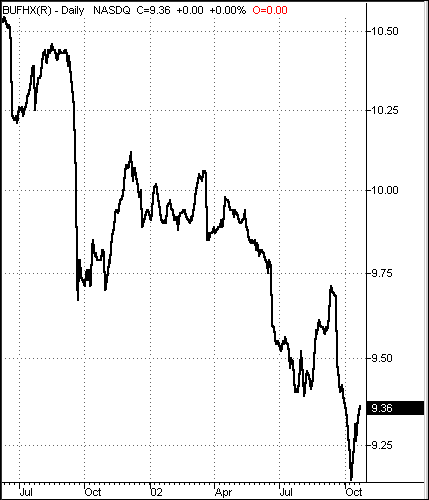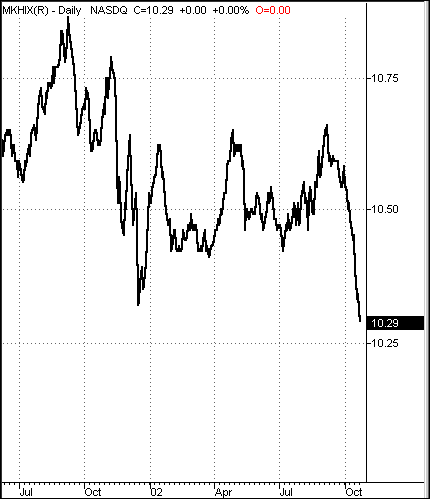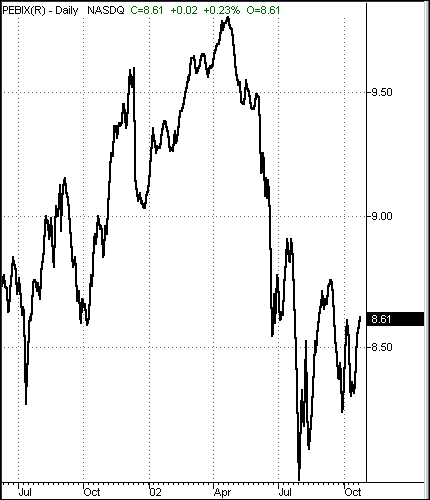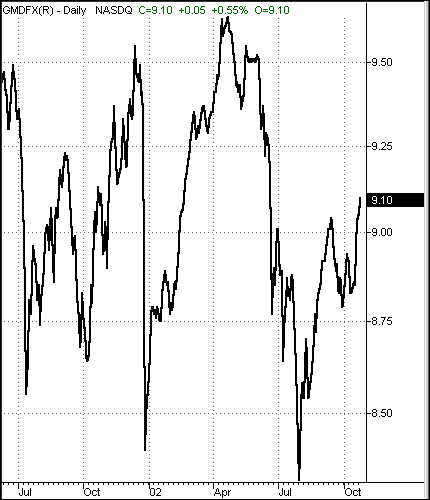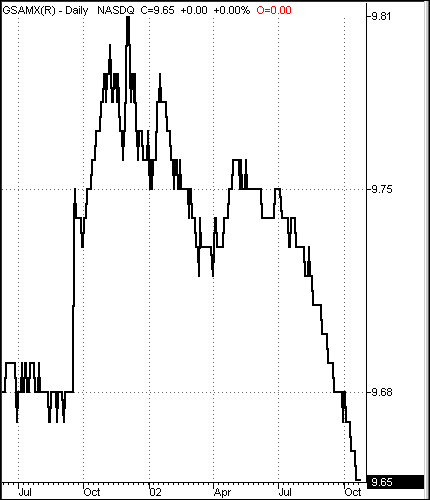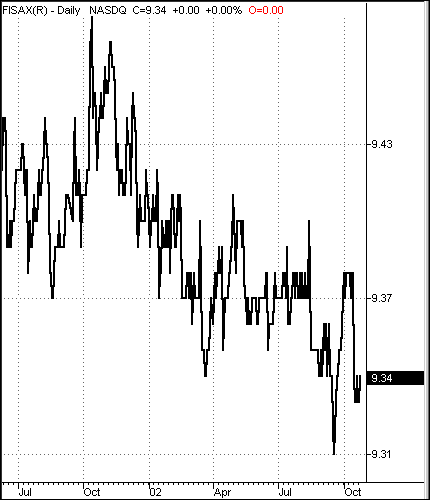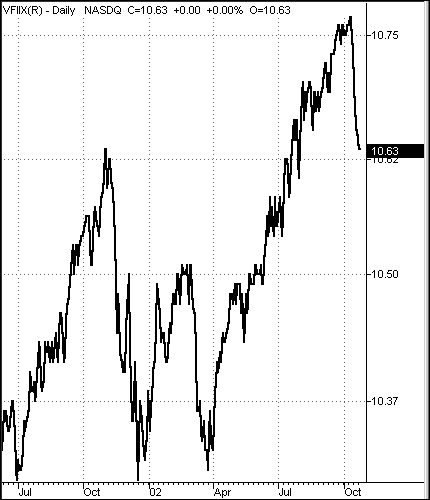
HOT TOPICS LIST
- Strategies
- Stocks
- Buy
- Investing
- Brokers
- Psychology
- Interviews
- Accumulate
- Sell
- Hold
- Spotlight
- Websites
- Candlestick Corner
- Gold & Metals
- Options Trading
LIST OF TOPICS
FOCUS ON
Bonds For All Occasions II
10/29/02 03:58:35 PM PSTby David Penn
A look at the junk, emerging market, mortgage-based, and adjustable-rate bond markets.
| Back in June, I examined the recent performance of a variety of bond funds as representatives of the diversity of bond investing strategies. The idea was to explore a theme in Mark Boucher's The Hedge Fund Edge that suggests there might in fact be a winning bond investment (relative to both cash and stocks) for every economic climate. The initial article (Bonds For All Occasions I) looked at the performance of zero coupon bonds, long-term and short-term bonds, and international bonds. For convenience and clarity, bond funds of these types were used then and will be used here, instead of individual bonds. The notion that a suitable bond market investment may exist for all economic environments might sound a bit facetious. After all, there have been inflationary episodes that have crushed bonds (such as the late 1970s). When times have been good, as during the secular bull market from 1982 to 2000, it was stocks, not bonds, that made investors giddy with spectacular returns. However, the record is clear that bonds can and do compete well with other asset classes. Moreover, the variety of bond funds is such that no other asset class performs as well in as many different types of economic climates: from inflation to deflation, recession to expansion. Zero coupon bonds were as good a bet as stocks during the bull market of the 1980s and 1990s as interest rates went into a secular decline. During the Great Depression — particularly from about 1932 — to the war years ending in 1945, top-quality corporate bonds enjoyed a bull market that was nothing short of remarkable, as investors in these bonds saw their investments grow by more than 50%. Here, I will examine four other bond types: junk bonds, emerging market debt, Ginnie Maes (the nickname for Government National Mortgage Association securities), and adjustable-rate bonds. Each bond type traditionally does well in a different economic climate from the others. This part of "Bonds For All Occasions" seeks to find out just how well these different bond types have done for investors — lately.
JUNK YIELDSThese bond funds invest in high-yielding or "junk" bonds. The "junk" moniker became particularly adhesive in the wake of the high-yield bond empire that was created by Michael Milken during the 1980s — and subsequently destroyed by regulators concerned about allegations of "parking" (essentially, trading under someone else's name in order to obscure real ownership of the securities) and insider trading. High-yield bonds are exactly what they sound like: bonds that are selling at a discount and that feature above-market yields. Why the price discount with premium yields? Unfortunately, the majority of companies that issue such bonds suffer from weak credit ratings or poor overall performance. Bluntly put, interest payments on these bonds must be higher than average because there is a reasonable chance that the bond investor will not receive the entire invested principal back when the bond matures. So why in the world would anyone want to invest in — well — junk? The argument in favor of junk or high-yield bonds suggests that these bonds outperform others at the beginning of an economic recovery. Thus, investment in junk or high-yield bonds is, in many ways, a value play on economic growth. While the zero coupon bonds discussed in "Bonds For All Occasions (I)" are the best, bond-oriented way of taking advantage of a secular shift toward lower interest rates (whether in response to perceived economic weakness or a disinflationary trend), high-yield bonds are among the preferred methods that many risk-tolerant investors use in order to take advantage of an economic environment that has just begun to turn around for the better. As Figures 1 and 2 show, a number of junk or high-yield bond funds have been under pressure for some time. One of the more recent top high-yield bond funds, the Buffalo High-Yield fund (BUFHX), has outperformed another dominated by similar funds from Regions Morgan Keegan (MKHIX) in more recent times. But the charts of both the Buffalo fund and the top-ranked Regions Morgan Keegan fund show that outperformance going forward will have to come as a result of a dramatic reversal in recent fortunes.
Figure 1: High-yield bond funds from the Buffalo High-Yield fund (BUFHX) have been among the top "junk" bond funds over three-month and one- to three-year periods, respectively.
Figure 2: High-yield bond funds from the Regions Morgan Keegan (MKHIX) have been among the top "junk" bond funds over three-month and one- to three-year periods, respectively.
EMERGING MARKETS, GROWING DEBT If emerging market stocks are seen as risky, then what is the conventional wisdom about emerging market debt? If you find it hard to answer without images of Argentina in 2002, Russia in 1998, and any one of a number of Asian countries in 1997, then the realities of everyday investing in emerging market debt might surprise you. In recent years, emerging market debt from countries like Russia has been the most outstanding investment, bar none. As Rebecca McCaughrin, Joe Quinlan, and Marcin Wiszniewski of Morgan Stanley noted this September:
With global uncertainty and market volatility subjecting emerging markets to greater scrutiny of late, Russia remains one of the key emerging markets about which investors are most hopeful. Our emerging markets' fixed income recently polled 42 investors in Europe and the US on the prospects for emerging market performance and found Russia again at the top of the survey, as has been the case for at least a year.
What is the argument for investing in bonds from countries with "emerging" (as opposed to mature) markets? In some ways, the argument is not too different from that in favor of high-yield bond investing. If junk bonds are a way of making a leveraged bet on an incipient economic recovery, emerging market bonds can be an equally risk-tolerant way of investing in a global economic recovery that has been all but confirmed. In a climate of general — or even regional — economic growth, goes the philosophy behind investment in emerging market debt, developing countries in the "Third World" often outgrow their developed counterparts in the First World. As represented by the PIMCO Emerging Markets (PEBIX) (Figure 3) and GMO Emerging Market Debt (GMDFX) funds (Figure 4), emerging markets bond funds climbed strongly in the second half of 2001 and peaked in the first few months of 2002. Along with the equities markets, interestingly enough, emerging market debt funds have rallied strongly from a July 2002 bottom, with funds such as GMO Emerging Market Debt having almost retraced half of the April to July collapse.
Figure 3: After peaking in the second quarter of 2002, emerging markets bond funds crashed over the following months. Here's the PEBIX.
Figure 4: After peaking in the second quarter of 2002, emerging markets bond funds crashed in recent months. Here's the GMDFX.
SHORT, ADJUSTABLE, AND HOMEYThe latter two categories of bond funds under discussion here, mortgage-based and adjustable rate, can be talked about in similar fashion. This is because many, if not most, adjustable-rate bond funds consist of investments in mortgage-backed securities from government agencies such as Fannie Mae (Federal National Mortgage Association) and Ginnie Mae. Smaller positions may be invested in other government-related securities, such as general agency debentures and a growing sub-asset class called asset-backed securities (ABS). Asset-backed securities are bonds that consist of pools of debt with similar duration and interest rates. While mortgages are also often bundled into ABS products, consumer and student loans play a large role as well. Boucher notes in his Hedge Fund Edge that adjustable-rate bond funds are a particularly strong bond play when concerns begin to grow about the economy overheating. Usually, this "overheating" is some measurable increase in inflation that is threatening to drive interest rates higher. By investing in adjustable-rate bond funds, investors can take advantage of these rising interest rates because the short-term durations of the securities in these funds allows investors to be continually invested in securities with higher and higher interest rate payments. As short-term debt matures, it is replaced in the adjustable-rate bond fund by more short-term debt. In a rising interest rate environment, the new short-term debt invariably features a higher interest rate. It is hardly surprising, then, that a fund such as the Goldman Sachs Adjustable Rate Government Fund is now called the Goldman Sachs Ultra-Short Duration Government Fund (GSAMX). The investment strategy of the fund has hardly changed. What, then, are the differences between adjustable-rate bond funds that invest in mortgages and Ginnie Mae bond funds that also invest in mortgages? Foremost is the fact that adjustable-rate bond funds may invest in mortgages, but only as part of an overall strategy of providing capital preservation and high income. Eurodollar futures, for example, are another way these "ultra-short" or adjustable-rate bond funds make money for investors. In addition, securitized mortgages from Freddie Mac (the Federal Home Loan Mortgage Corp., or FHLMC) and Fannie Mae are more commonly found in adjustable-rate bond funds. Ginnie Mae bond funds, by comparison, invest solely in Ginnie Maes. The other main difference is, of course, duration. Compare the Vanguard GNMA bond fund to the Goldman Sachs Ultra-Short Duration Government bond fund (this fund was previously called the Goldman Sachs Adjustable Rate Government Fund). The average duration of the Ginnie Mae fund is 4.14 years, with an average maturity of six years. The average duration of the Goldman Sachs fund is closer to six months. The difference between the two types of funds is all the more clear when the two types of bond funds in Figure 5, the chart of the Goldman Sachs (GSAMX), and Figure 6, the Franklin Adjustable US Government Securities (FISAX) are compared with each other. Then compare the GSAMX or the FISAX bond fund with the chart of the Vanguard Ginnie Mae fund (VFIIX) in Figure 7.
Figure 5: Adjustable rate and "ultra-short" term bond funds have been declining for at least a year, as these funds from Goldman Sachs (GSAMX) show.
Figure 6: Adjustable rate and "ultra-short" term bond funds have been declining for at least a year, as these funds from Franklin Templeton (FISAX) show.
Figure 7: Peaking in late September, this Vanguard Ginnie Mae fund has begun to slip after a powerful, six-month rally.
Falling long-term interest rates have helped funds such as the Vanguard Ginnie Mae fund turn in a strong performance in 2002, while the same interest rate environment has kept adjustable-rate and ultra-short bond funds in a steady, albeit relatively mild, decline. The recent "spikelet" in 10-year Treasury yields in October has had its effect on Ginnie Mae funds, however, as Figure 7 suggests. Whether this is a sign to shift away from Ginnie Mae funds, or merely a brief correction, remains to be seen. But given the inverse correlation that Ginnie Mae funds and adjustable-rate funds have featured in 2002, watching both types of bond fund may be the best way of determining whether a true turn is at hand. In fact, this isn't a bad recommendation for determining the right time for any timing-based, bond investment approach. In The Hedge Fund Edge, Boucher goes so far as to suggest that "aggressive bond investors" may be able to play the entire economic cycle from contraction to expansion and back again to contraction simply through well-timed and well-placed bond investments. He notes:
The key points here are (1) there is almost always a bond investment making money in any kind of imaginable environment; and (2) if you can reliably determine which way interest rates and the economy are heading, you can adjust your bond investments to profit from the environment . . . buying long zero-coupon bonds as the economy weakens and goes into recession . . . moving out of zero-coupon bonds and into long bonds or convertibles on the first hints of decent economic growth moving into junk bonds or emerging market debt as the recovery becomes clearly established . . . moving into adjustable rate junk, adjustable rate short bonds, and distressed bonds as the economy begins to show signs of overheating.
In an era of exceptionally uncertain equity returns and historically low dividend yields, this sounds like a cycle worth investigating.
David Penn may be reached at DPenn@Traders.com.
SUGGESTED READINGBoucher, Mark [1999]. The Hedge Fund Edge, John Wiley & Sons.McCaughrin, Rebecca, Joe Quinlan, and Marcin Wiszniewski [2002]. "Russia: Dim Outlook For Foreign Investment," Morgan Stanley Global Economic Forum. Penn, David [2002]. "Bonds For All Occasions (I)," Working Money, June 18. Renberg, Werner [1995]. All About Bond Funds, John Wiley & Sons. Sease, Douglas, and John Prestbo [1999]. Barron's Guide To Making Investment Decisions, New York Institute of Finance. Thau, Annette [1992]. The Bond Book, Probus Publishing. TradeStation (TradeStation Technologies)
Current and past articles from Working Money, The Investors' Magazine, can be found at Working-Money.com.
|
Technical Writer for Technical Analysis of STOCKS & COMMODITIES magazine, Working-Money.com, and Traders.com Advantage.
| Title: | Traders.com Technical Writer |
| Company: | Technical Analysis, Inc. |
| Address: | 4757 California Avenue SW |
| Seattle, WA 98116 | |
| Phone # for sales: | 206 938 0570 |
| Fax: | 206 938 1307 |
| Website: | www.traders.com |
| E-mail address: | DPenn@traders.com |
Traders' Resource Links | |
| Charting the Stock Market: The Wyckoff Method -- Books | |
| Working-Money.com -- Online Trading Services | |
| Traders.com Advantage -- Online Trading Services | |
| Technical Analysis of Stocks & Commodities -- Publications and Newsletters | |
| Working Money, at Working-Money.com -- Publications and Newsletters | |
| Traders.com Advantage -- Publications and Newsletters | |
| Professional Traders Starter Kit -- Software | |
PRINT THIS ARTICLE

|

Request Information From Our Sponsors
- StockCharts.com, Inc.
- Candle Patterns
- Candlestick Charting Explained
- Intermarket Technical Analysis
- John Murphy on Chart Analysis
- John Murphy's Chart Pattern Recognition
- John Murphy's Market Message
- MurphyExplainsMarketAnalysis-Intermarket Analysis
- MurphyExplainsMarketAnalysis-Visual Analysis
- StockCharts.com
- Technical Analysis of the Financial Markets
- The Visual Investor
- VectorVest, Inc.
- Executive Premier Workshop
- One-Day Options Course
- OptionsPro
- Retirement Income Workshop
- Sure-Fire Trading Systems (VectorVest, Inc.)
- Trading as a Business Workshop
- VectorVest 7 EOD
- VectorVest 7 RealTime/IntraDay
- VectorVest AutoTester
- VectorVest Educational Services
- VectorVest OnLine
- VectorVest Options Analyzer
- VectorVest ProGraphics v6.0
- VectorVest ProTrader 7
- VectorVest RealTime Derby Tool
- VectorVest Simulator
- VectorVest Variator
- VectorVest Watchdog

